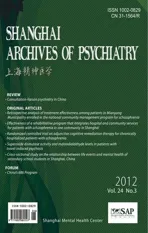Cross-sectional study on the relationship between life events and mental health of secondary school students in Shanghai, China
2012-07-10LinlinZHOUJuanFANYasongDU
Linlin ZHOU, Juan FAN, Yasong DU*
Cross-sectional study on the relationship between life events and mental health of secondary school students in Shanghai, China
Linlin ZHOU, Juan FAN, Yasong DU*
Background:The relationship of demographic factors and negative life events to the mental health of mainland Chinese school students has not been fully explored.
Aim:Assess the prevalence of different types of life stressors among secondary school students and identify the demographic characteristics and types of life events that are most closely associated with perceived psychological difficulties in these students.
Methods: This cross-sectional study administered two self-completion questionnaires to a stratified random cluster sample of 1818 students from four secondary schools in two districts of Shanghai: the Strengths and Difficulties Questionnaire (SDQ) and an abbreviated version of the Adolescent Self-rating Life Events Checklist (ASLEC) that assesses 11 negative life events.Results:Academic stress (74%), criticism from others (66%), family conflict (29%) and peer bullying & discrimination or interpersonal conflict (26%) were the most frequently reported negative life events, but their prevalence varied significantly by gender, type of school and urban versus rural residence. Similarly the level of reported psychological stress associated with life events, the total perceived psychological difficulty, and the level of pro-social behavior in the students varied significantly between different groups of students. Multivariate linear regression analysis identified the following independent predictors of high perceived psychological difficulty in the prior 6 months (in order of importance): high total stress score from negative life events in the prior year, experiencing peer bullying & discrimination or interpersonal conflict, not experiencing the death of a family member, male gender, attending a school in a rural district, and not suffering from a major disease or physical impairment. The independent predictors of a high level of pro-social behavior were high total stress score from negative life events, attending an urban school, female gender, attending a regular-tier school (vs. a high-tier school), experiencing peer bullying & discrimination or interpersonal conflict, not experiencing the death of a family member, and attending a middle school (vs. a high school).
Conclusion:Negative life events are one of many factors associated with perceived stress and level of pro-social behavior in secondary school students. Prospective studies are needed to clarify the causal pathways that connect stress with negative life events in students and to develop and test cohort-specific interventions aimed at decreasing stress and increasing prosocial behaviors.
1. Introduction
Secondary school students experience dramatic physiological and psychological changes as well as increasing pressure associated with social competition. Consequently, the mental health of this population has become an increasing concern for society. Surveys in China indicate that 12.9 to 23.2% of adolescents have psychological or behavioral problems.[1-3]Negative life events can act as psychological stressors that affect the mental health of adolescents.[4-6]In the present crosssectional study we assess the relationship of negative life events to the psychological health of secondary school students in Shanghai, China.
2. Subjects and methods
2.1 Subjects
As shown in Figure 1, subjects were selected by stratified random cluster sampling. One urban district (i.e., Xuhui) and one suburban district (i.e., Songjiang)in Shanghai were randomly chosen from all districts in Shanghai. Two high schools (one top-tier and one regular-tier) and two middle schools (one top-tier and one regular-tier) were randomly chosen from the high schools and middle schools in each of the two districts. (‘Top-tier’ schools have higher standards for admission and get better financial support from the community.) Two classes were randomly selected from all classes in each grade for each of the three grades in each school (grades 7,8,9 for middle schools and grades 10,11,12 for high schools). This resulted in a total sample of 1860 students. All participating students and a parent for each participating student signed a written consent form to participate in the study. The surveys were conducted over a two-week period in March 2007.
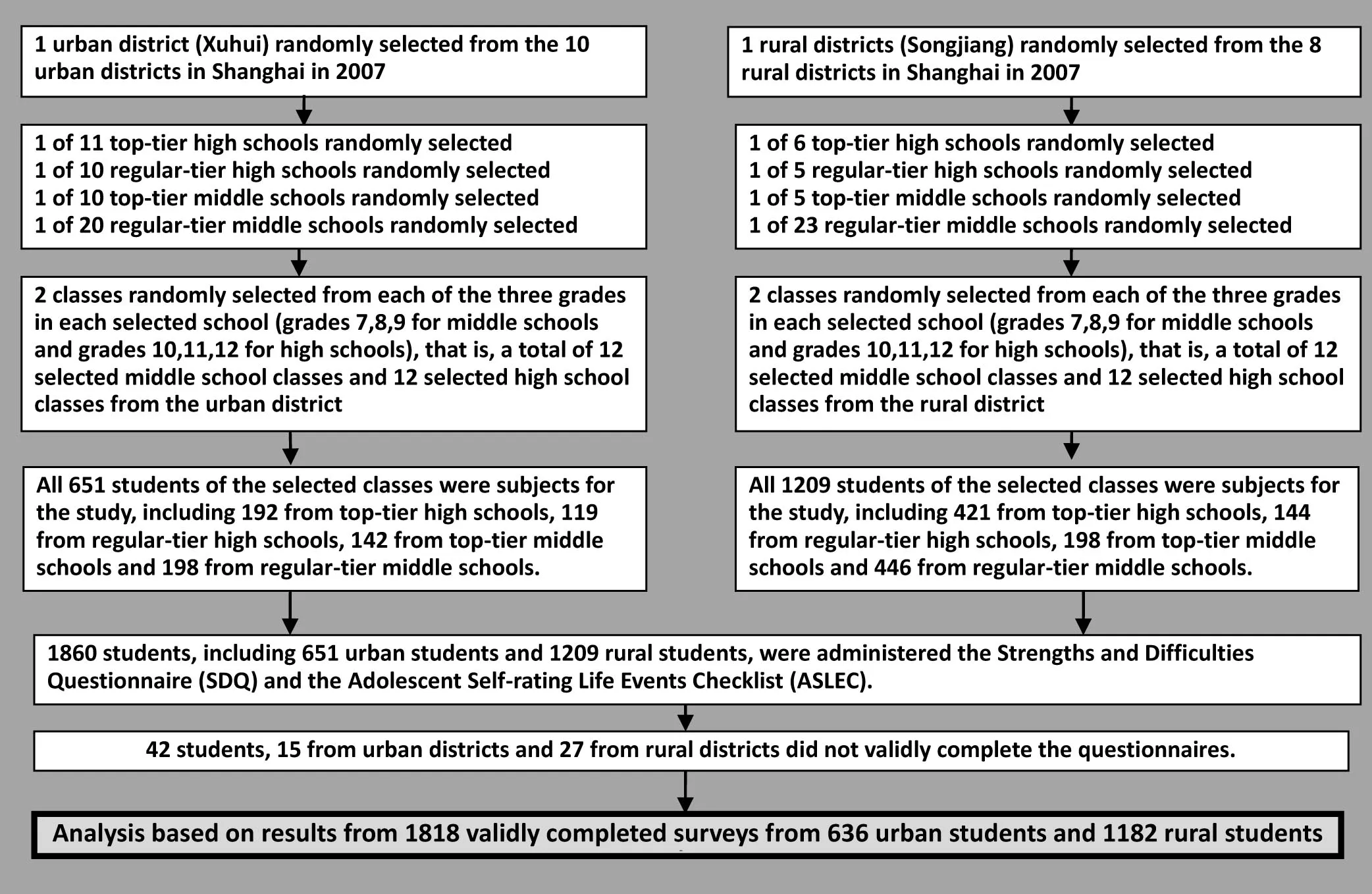
Figure 1. Flowchart for enrollment in the study
2.2 Instruments
The student version of the self-report Strengths and Difficulties Questionnaire (SDQ) was used to assesses the psychological status of respondents over the prior 6 months. After its introduction in 1997 by Goodman, this questionnaire has been successfully administered in 40 countries and regions as a brief behavior screening tool with excellent reliability and validity.[7-9]The SDQ contains 25 items (psychological attributes) divided between 5 scales with 5 items each: emotional symptoms, conduct problems, hyperactivity/inattention, peer relationship problems, and pro-social behavior. Each item is scored on a 3-point scale (0=normal, 1=borderline, 2=abnormal) so each of the five subscales has a range of 0 to 10. The total score on the first four subscales is used as the measure of overall level of difficulty (range=0-40, with higher scores representing greater difficulty). The score on the last scale (pro-social behavior) measures the level of strengths, with higher scores representing better psychological health. In a previous study among Shanghai students[7]the reported alpha values for the five scales ranged from 0.66 to 0.77 and the alpha for the 20 items used to compute the total score was 0.79; the 6-week test-retest reliability for the 5 subscales was fair (Pearson correlation coefficient=0.48-0.74) and the test-retest reliability of the overall SDQ score was good (r=0.72).
The Adolescent Self-rating Life Events Checklist[10](ASLEC) is used to assess the frequency and intensity of psychological stressors experienced by subjects. In the present study, 11 major negative life events relevant for students were selected from the 27 life events considered by the ASLEC: peer bullying or interpersonalconflict, major academic stress or failure, intra-family conflict or poor parent relationship, major disease or physical impairment, family financial difficulty, abuse (physical, emotional or sexual), death of a family member, parental divorce, criticism from others, accidents, and other negative events. The respondent codes the time of occurrence of each life event (1=did not occur; 2=more than 12 months ago; 3=within the past 12 months; 4=currently ongoing) and rates the psychological impact of the life event (1=no effect; 2=mild; 3=moderate; 4=severe; 5=extremely severe). The product of these two codes is the stress score for each life event (range=1-20), with higher scores representing greater stress related to the life event.[10,11]An overall life-event related stress score is the simple sum of the 11 separate stress scores (range=11-220).
2.3 Conduct of the survey
Survey forms were distributed to subjects in each class by their teachers. Survey staff (5 psychiatrists) who had received training in the process of conducting the survey explained the instructions to the students, answered any questions they had about the content of the questionnaire, and checked the completed questionnaires for missing items when the students handed in the completed questionnaires. On average it took students 15 minutes to complete the questionnaire. The questionnaire was not completed anonymously; students wrote their names at the top of the form.
2.4 Statistical analysis
SPSS 12.0 software (SPSS, Chicago, IL, USA) was used to analyze the results. Data were assessed using descriptive analysis, t-tests, χ2tests, Mann-Whitney tests for ranked variables, and multivariate regression analyses. The distribution of the stress scores for individual life events were quite skewed and many of these events occurred in less than 25% of respondents so the interquartile ranges showed no variation between groups; for these variable we present the mean and standard deviation of the scores (which provides information about the distribution) but use Mann-Whitney tests to make comparisons across groups. Multivariate linear regression models were used to identify demographic and life-event variables that were independently related to perceived difficulty and prosocial behavior as assessed by the SDQ. The demographic variables (gender, urban versus rural school, high-tier versus regular-tier school, high school versus middle school, and grade level) were forced into the regression models and then the life event variables (total stress score from all 11 negative life events, number of life events, and presence or absence of each of the separate 11 life events) were entered in a stepwise manner, only retaining the life event variables that are statistically significant in the model. Age was not included in the model because grade level is very closely related to age.
The study was approved by the Institutional Review Board of the Shanghai Mental Health Center.
3. Results
3.1 General results
A total of 1818 of the 1860 distributed survey forms (97.74%) were validly completed. Subjects who validly completed the survey included 871 males (48.3%) and 947 females (51.7%) with a mean (sd) age of 15.3 (1.7) years (range 12-19 years of age); 967 (53.2%) were from middle schools and 851 (46.8%) were from high schools; 636 (35.0%) were from urban districts and 1182 (65.0%) were from rural districts; and 921 (50.7%) were from top-tier schools and 897 (49.3%) were from regular-tier schools.
The 42 students who did not complete valid forms include 19 males and 23 females with a mean age of 15.5 (1.8) years. There were no statistically significant differences in age (t=–0.79, p=0.432) or gender (χ2=0.12, p=0.732) between the subjects who provided a valid survey and those who did not.
3.2 Negative life events
The prevalence of negative life events in all students and stratified by gender, by type of school (middle school or high school) and by residence (urban or rural) is shown in Table 1. The most common life events for all groups were academic stress and experiencing criticism from others. Most of the negative life events were more frequently reported by males than females, particularly abuse, accidents, and bullying. Academic stress, intrafamily conflict and accidents were more commonly reported by high school students than by middle school students. And compared to students from urban schools, students from rural schools were more likely to report negative life events related to academic stress, bullying, intra-family conflict, or being criticized by others.
The range in the total number of negative life events reported at any time in the past was from 0-11; the mean (sd) was 2.6 (1.8) and the median (IQR) was 2 (1-4). Male students reported more negative life events than females [median (IQR)=3 (2-4) versus 2 (1-3), U=-2.82, p=0.005]; high school students reported more negative life events than middle school students [2 (1-4) versus 2 (1-4), U=2.01, p=0.045]; and rural students reported more negative life events than urban students [3 (2-4) versus 2 (1-3), U=4.90, p<0.001].
3.3 Perceived level of difficulties and stress from negative life events.
The SDQ results (Table 2) show that female students had significantly higher scores for emotional symptoms and for pro-social behaviors than male students, but male students report more difficulties with conduct problems, hyperactivity/inattention and peer relationships, and they have higher overall difficulty scores. The overall life-event related stress score for males was significantly higher than that for females and the stress associated with several specific life events was also higher in males than females, including abuse, accidents, major disease, peer bullying and interpersonal conflict, criticism from others, and family financial difficulty.
Comparison of the SDQ and life event stress results for middle school students versus high school students and for students from rural schools versus those from urban schools are shown in Table 3. Middle school students had significantly higher scores for peer relationship problems and conduct problems than high school students while high school students had higher scores for emotional symptoms and hyperactivity/inattention. Middle-school students also scored higher on pro-social behaviors. The stress associated academic problems and family conflict was significantly greater in high school students than in middle-school students but the stress associated with criticism from others and abuse was significantly greater in middle school students.
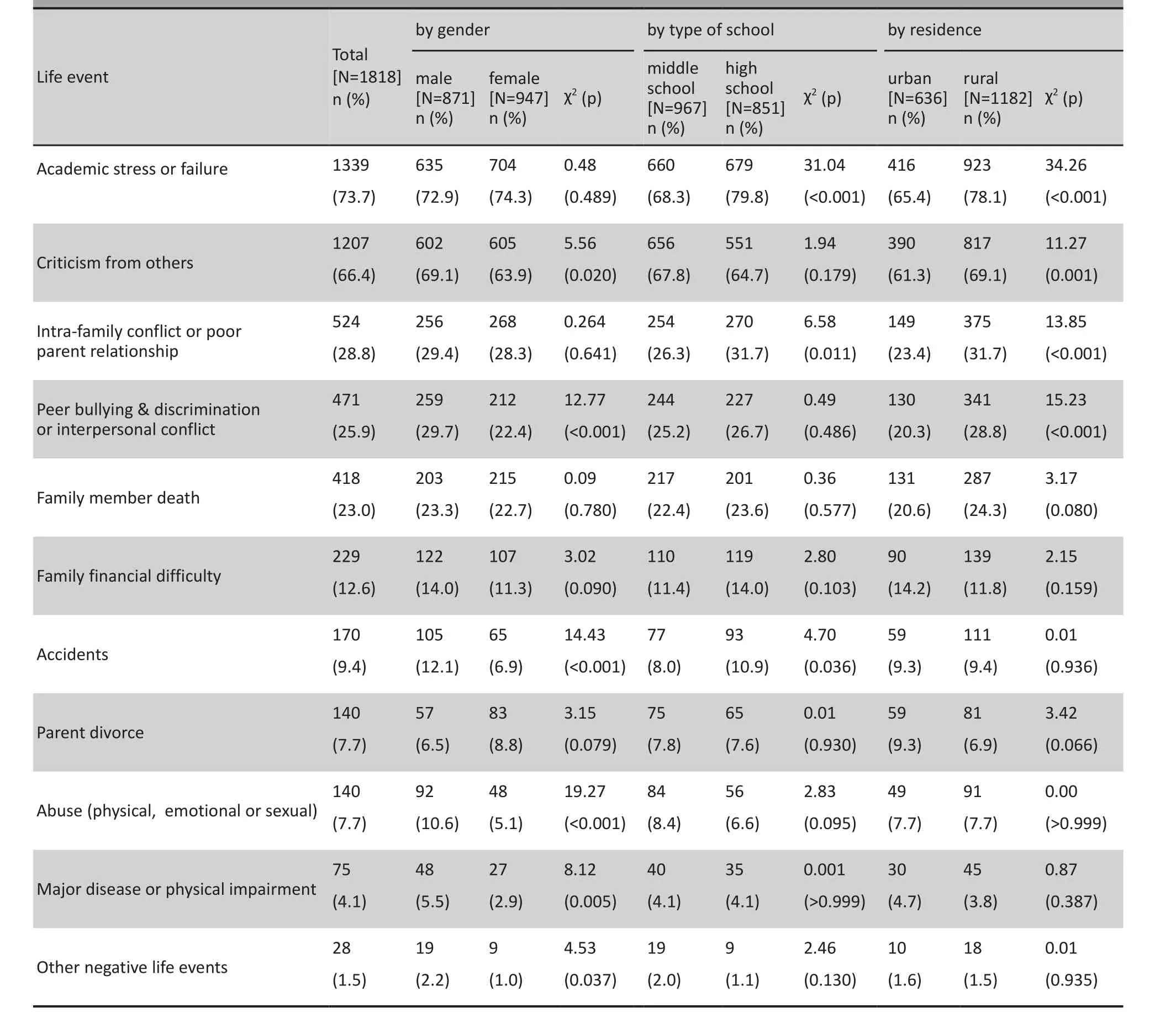
Table 1. Prevalence of different types of life events (experienced at any time in the past) in different sub-populations of students
Students from rural schools had higher overall difficulty scores than students from urban schools and the scale scores for hyperactivity/inattention and emotional symptoms were also higher in rural students, but the mean scores for pro-social behaviors were much higher in urban students than in rural students. Overall stress from negative life events was higher in rural students than urban students and the stress associated with academic problems, bullying or interpersonal conflict, intra-family problems, and criticism from others was also higher in rural students.
3.4 Multivariate assessment of factors associated with perceived difficulty and pro-social behavior
The results of the multivariate linear regression analyses are show in Table 4. The factors that were significantly associated with high overall perceived difficulty (in order of importance) include: high total stress score from negative life events, experiencing peer bullying & discrimination or interpersonal conflict, not experiencing the death of a family member, male gender, attending a school in a rural district, and notsuffering from a major disease or physical impairment. After adjustment for all variables in the model, perceived difficulty was not independently associated with gradelevel, type of school (high school vs. middle schools or high-tier vs. regular-tier school) or with the occurrence of any of the other eight negative life events.
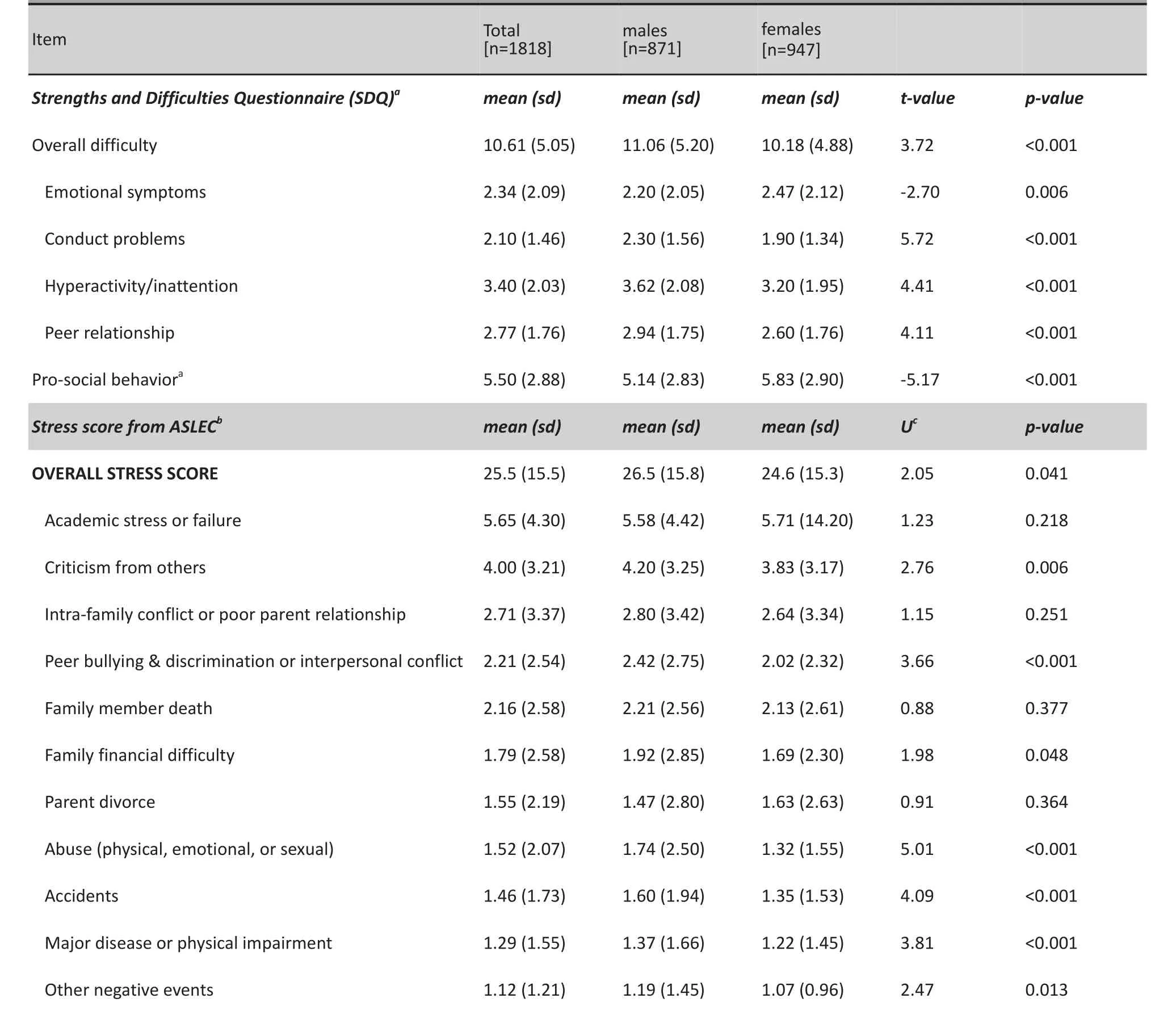
Table 2. Comparison of the SDQ and ASLEC results for male and female subjects
The variables significantly associated with high levels of pro-social behavior (in order of importance) include: high total stress score from negative life events, attending an urban school, female gender, attending a regulartier school, experiencing peer bullying & discrimination or interpersonal conflict, not experiencing the death of a family member, and attending a middle-school. Grade level and experiencing any of the remaining nine negative life events was not related to the level of prosocial behavior.
近几年来,随着旅游电子商务和自助游的发展,很多旅游消费者选择在线预订旅游产品和服务,促使旅游服务供应链发生了变化,形成了以旅游网站为核心的在线旅游服务供应链模式。通过提高全产业链的整合能力,有助于优化相关企业间的关系,产生协同效应,降低运营成本、增加盈利空间。

Table 3. Comparison of the SDQ and ASLEC results by type of school and by location of school
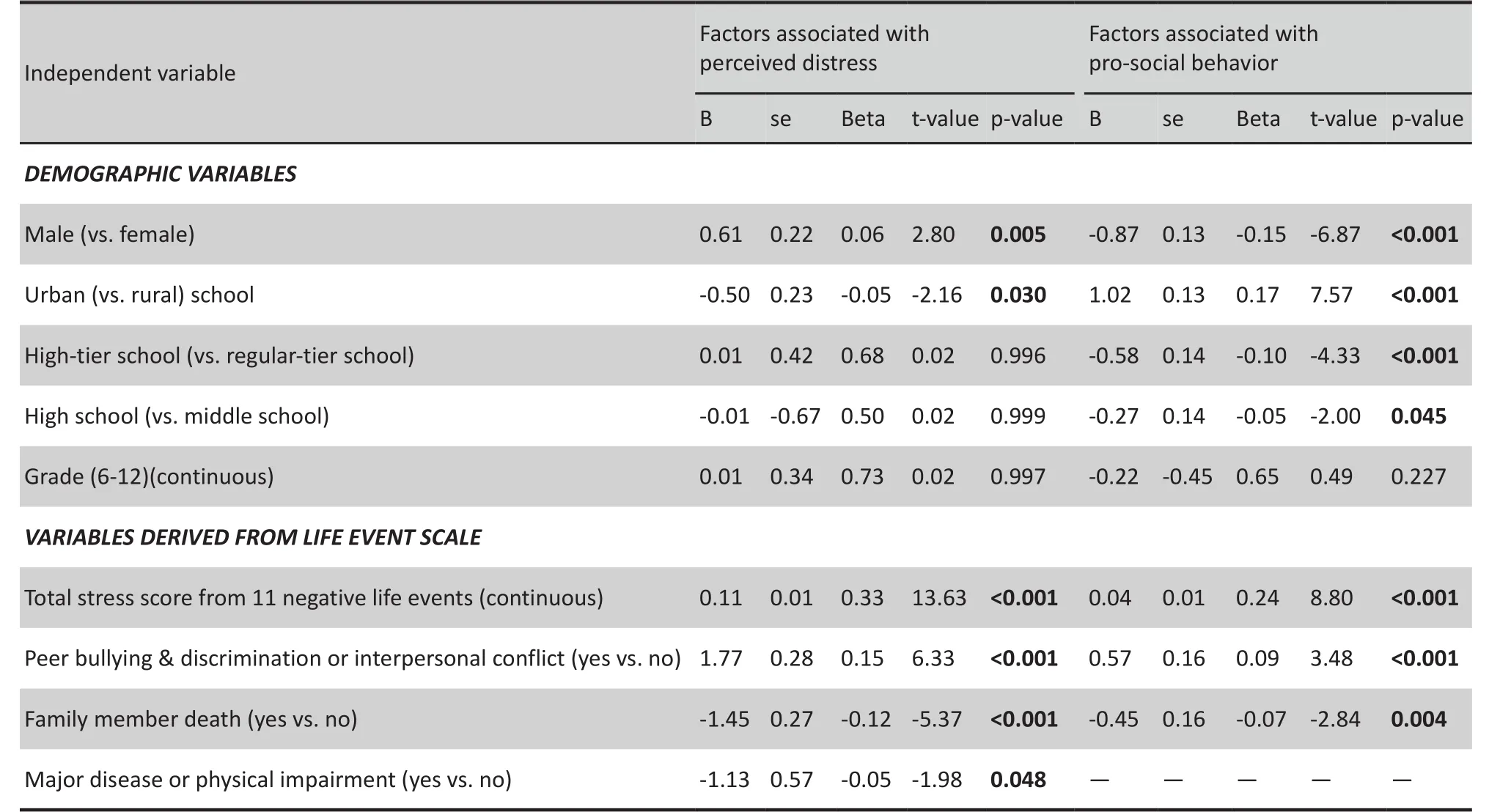
Table 4. Multiple regression results identifying factors associated with total perceived distress and pro-social behaviors as assessed by the SDQ in 1818 students from secondary schools in Shanghaia
4. Discussion
4.1 Main findings
We found that academic stress (74%), criticism from others (66%), family conflict (29%) and peer bullying & discrimination or interpersonal conflict (26%) are the most frequently reported negative life events for secondary students in Shanghai. The prevalence of these events, severity of the psychological stress associated with negative life events, overall perceived psychological difficulty, and level of pro-social behaviors in the students varied significantly by gender, type of school and urban versus rural residence. Male students reported more negative life events, greater stress related to negative life events, and a higher level of perceived psychological difficulty. Meanwhile female students reported higher levels of pro-social behaviors. The overall stress associated with negative life events in the prior year was the most important predictor of self-reported psychological difficulties (i.e., poor ‘mental health’) over the last six months.
These findings are largely consistent with other studies in China and elsewhere. Several studies find that male students have more conduct problems and interpersonal relationship problems than female students[9], and many studies with different types of students find that negative life events can affect the psychological health of students.[4-6,12-16]Where we depart from previous studies is that we computed an overall stress score (by simply adding the stress scores for each of the 11 life events recorded) and found that this measure was the most powerful predictor of perceived psychological difficulty. This suggests that interventions should place more emphasis on reducing stress generally (e.g., stress management techniques) rather on trying to reduce the occurrence of specific negative life events. Moreover, in the multivariate model male students and students from rural schools reported significantly more psychological difficulties so there clearly needs to be some differentiation in the approaches taken to address the problem of student stress in different cohorts of students.
After adjusting for demographic variables and overall life event-related stress, the only remaining factors independently associated with perceived difficulty were: a) experiencing peer bullying & discrimination or interpersonal conflict; b) not experiencing thedeath of a family member, and c) not suffering from a serious physical illness or disability. ‘Peer bullying and discrimination’ is quite different from ‘interpersonal conflict’ so it will not be possible to interpret this finding— or to develop appropriate interventions — until the two phenomena are differentiated. The findings that the occurrence of a family death and the presence of a serious medical illness or disability are associated with low psychological difficulty are counter-intuitive; followup qualitative work is needed to identify the reasons for this unexpected finding.
We also assessed the factors associated with high levels of pro-social behavior, something that has not been reported previously in China. Not surprisingly, the associated demographic factors were opposite to those found for high perceived psychological difficulty. Where high perceived difficulty was greatest in male students and in those from rural schools, high levels of pro-social behaviors were more common in female students and in students from urban schools. The finding that pro-social behavior was more common in students from regulartier schools than those from high-tier schools and for students in middle schools than students in high schools requires some further explanation; it may be related to the greater level of competition in high-tier schools compared to regular-tier schools and in high schools compared to middle schools. Somewhat surprisingly, high levels of overall stress from negative life events and experiencing peer bullying & discrimination or interpersonal conflict were also associated with high levels of pro-social behavior. Here, again, prospective studies and qualitative studies are needed to help clarity the relationships between these variables.
4.2 Limitations
Several issues need to be considered when interpreting these results. This large sample is a reasonable representative of students in the two selected districts of Shanghai in 2007 but it may not be representative of other districts in Shanghai or, given the rapid rate of social change in urban China, of the current situations of middle-school students. In particular, the students from ‘rural’ schools in Shanghai are definitely not representative of students from other parts of rural China; we expect the differential results seen in this study for urban and rural students would be much greater if students from rural provinces in China were surveyed.
The current analysis combines three types of life events, those that occurred more than one year ago, those that occurred in the last year but did not have a psychological effect on the respondent at the time of the survey, and those that continued to have a psychological effect on the respondent at the time of the survey. A stratified analysis would be needed to determine whether or not the effects of these different types of life events on the current level of perceived difficulty in students is different. The study selected 11 of the 27 life events included in the ASLEC, but there are no separate reliability and validity parameters for this subset of items from the ASLEC so there remains some doubt about the appropriateness of this abbreviated version of the instrument. And the combination of ‘peer bullying & discrimination’ and ‘interpersonal conflict’ in a single life event on the ASLEC makes it impossible to distinguish these very different situations, situations that have different causes and need different interventions; in subsequent studies these life events should be listed as separate items.
Other potential confounding factors such as academic performance, family financial status, academic level of parents, and so forth were not considered in the analysis of the factors associated with overall perceived difficulty of the students; the results may be different if these additional factors are considered. Given the very large sample size many small differences identified between groups that are probably of little practical significance did, nevertheless, reach statistical significance so readers need to consider both the statistical significance and the magnitude of the differences. Our analysis only considers factors associated with total perceived difficulty; secondary analyses of factors associated with each of the four types of difficulties assessed by the SDQ could provide a more nuanced assessment of the relationships of these issues. Finally, this is a crosssectional study so it is only able to identify associations, it cannot determine cause-effect relationships. Longterm prospective studies are needed to determine the extent to which the stress associated with life events causes perceived difficulties in students.
4.3 Significance
This large, representative cross-sectional study found a strong relationship between the overall stress associated with life events and the level of perceived difficulty reported by middle school students in Shanghai. There were, moreover, substantive differences in the prevalence of different types of life events, in the stress associated with life events, in the perceived psychological difficulties, and in the level of pro-social behavior of students by gender, type of school, and residence (urban versus rural). Prospective studies that will help clarify the causal direction of these relationships and intervention studies that use this information to test different targeted programs for reducing stress and promoting pro-social behaviors in different cohorts of students are urgently needed.
Acknowledgements
We are grateful to Drs. Guofang Zhang (Mental Health Center, Xuhui district, Shanghai) and Yongxiang Wang (Mental Health Center, Songjiang district, Shanghai) for their assistance and support of this study.
Conflict of interest
The authors report no conflict of interest related to this study.
Funding
The study was supported by a Key Grant from the Shanghai Municipal Center for Disease Control and Prevention.
1. Twenty-two City Collaborative Survey Workgroup. Children’s behavior problems and their influential factors: a collaborating survey of 24 013 subjects in 22 cities in China.Chin Ment Health J1993; 7(1): 13-15. (in Chinese)
2. Niu XL, Zhang HY. Psychological health and influence factors of middle school students in Yinchuan city.Chinese Journal of School Doctor2007; 21(3): 265-267. (in Chinese)
3. Zhang YM, Xiao XF, Zhang JM. Investigation of psychological status among adolescents in Zhejiang Province.Zhejiang Medical Journal2005; 27(8): 563-565. (in Chinese)
4. Yang JW, Feng YX, Zhang JP, Dong MH, Kong QL. Negative life events and their mental influence among students of primary and secondary schools and institutions of higher learning.Chinese Journal of Health Education2003; 19(1): 12-16. (in Chinese)
5. Zhang ZQ, Guo LT. Research on stressful life events and related factors of middle school students in Chengdu.Chinese Journal of School Doctor2004; 18(2): 105-108. (in Chinese)
6. Xu BY, Chen BW, Ni ZZ, Huang XZ. Canonical correlation analysis of behavioral, emotional problems and life events among adolescents.Chinese Journal of Evidence-Based Medicine2004; 4(4): 263-266. (in Chinese)
7. Kou JH, Du YS, Xia LM. Formulation of Children Strengths and Difficulties Questionnaire (the Edition for Students) for Shanghai norm.China Journal of Health Psychology2007; 15(1): 3-5. (in Chinese)
8. Hu ZY, Zhang GY, Xie SG. The mental health status of 1175 adolescent students in Ningbo.Shanghai Arch Psychiatry2007; 19(5): 260-263. (in Chinese)
9. Du YS, Kou JH, Wang XL, Xia LM, Zou RH. Strengths and Difficulties Questionnaire research.Psychological Science2006; 29(6): 1419-1421. (in Chinese)
10. Liu XC, Liu LQ, Yang J, Chai FX, Wang AZ, Sun LM, et al. Reliability and validity of Adolescent Self-rating Life Events Check-list.Chinese Journal of Clinical Psychology1997; 5(1): 34-36. (in Chinese)
11. Zhou LL, Fan J, Du YS. Depressive symptoms and life events in middle school students in Shanghai.Shanghai Arch Psychiatry2009; 21(3): 133-135. (in Chinese)
12. Rabkin JG, Struening EL. Life events, stress and illness.Science1976; 194: 1013-1020.
13. Yu XX. Stressful life events on psychological health of junior school students.Journal of Wuzhou Teachers College of Guangxi2002; 18(3): 55-58. (in Chinese)
14. Tao FJ, Zeng GY, Zhang HB, Xu Y, Xu SJ, Wang HS. Negative life events and their impact on psychological health of middle school students.Chinese Journal of School Doctor1998; 12(1): 10-14. (in Chinese)
15. Simmons RG, Burgeson R, Carlton-Ford S, Blyth DA. The impact of cumulative change in early adolescence.Child Dev1987; 58(5): 1220-1234.
16. Seedat S, Stein DJ, Jackson PB, Heeringa SG, Williams DR, Myer L. Life stress and mental disorders in the South African stress and health study.S Afr Med2009; 99(5 Pt 2): 375-382.
17. Kerfoot M, Koshyl V, Roganov O, Mikhailichenko K, Gorbova I, Pottage D. The health and well-being of neglected, abused and exploited children: The Kyiv Street Children Project.Child Abuse Negl2007; 31(1): 27-37.
背景在国内,学生的人口学特征及负性生活事件与其心理健康的关系尚未得到充分的研究。
目的评估中学生中各种生活应激事件的发生率,确定与中学生自我感知的心理健康问题密切相关的人口学特征和生活事件的类型。
方法采用分层随机抽样的方法进行横断面调查,抽取上海市 2 个区 4 所中学共 1818 名学生,应用 2 种自评问卷进行评估:长处与困难问卷(Strengths and Difficulties Questionnaire,SDQ)学生版和用于评估11项负性生活事件的简易版青少年生活事件量表(Adolescent Self-rating Life Events Checklist,ASLEC)。
结果中学生报告的常见负性生活事件为学习压力(74%),受到批评(66%),家庭冲突(29%)以及受人欺负、歧视或人际关系紧张(26%),但是这些事件的发生率因学生的性别、学校类型以及所处城郊位置不同而有所差异。同样,不同组别的学生其生活事件所致心理应激水平、心理困难总分以及社会行为水平亦有所不同。多因素线性回归分析表明,评估前 6 个月内心理困难的独立预测因素依次为(按照重要性先后顺序):过去一年内负性生活事件所致的应激总评分高,受人欺负、歧视或人际关系紧张,没有发生亲人死亡,男性,学校位于郊区,以及未患重病或残疾。社会行为水平的独立预测因素依次为负性生活事件所致的应激总评分高,学校位于城区,女性,普通中学(与重点中学比),受人欺负、歧视或人际关系紧张,没有发生亲人死亡,初中(与高中比)。结论与中学生的应激和社会行为相关的众多因素之一是负性生活事件。进一步需要开展前瞻性研究以阐明中学生应激与负性生活事件的因果关系,开展并验证人群特异性的干预方法以减轻应激、增加适应性社会行为。
上海市中学生心理健康状况与生活事件之间关系的横断面研究
周琳琳 范娟 杜亚松*
上海交通大学医学院附属精神卫生中心,上海
*通信作者:yasongdu@yahoo.com.cn
2012-01-12; accepted: 2012-05-02)
10.3969/j.issn.1002-0829.2012.03.006
Shanghai Mental Health Center, Shanghai Jiao Tong University School of Medicine, Shanghai, China
*Correspondence: yasongdu@yahoo.com.cn
猜你喜欢
杂志排行
上海精神医学的其它文章
- Consultation-liaison psychiatry in China
- Retrospective analysis of treatment effectiveness among patients in Mianyang Municipality enrolled in the national community management program for schizophrenia
- Effectiveness of a rehabilitative program that integrates hospital and community services for patients with schizophrenia in one community in Shanghai
- Randomized controlled trial on adjunctive cognitive remediation therapy for chronically hospitalized patients with schizophrenia
- Superoxide dismutase activity and malondialdehyde levels in patients with travel-induced psychosis
- How to avoid missing data and the problems they pose: design considerations
